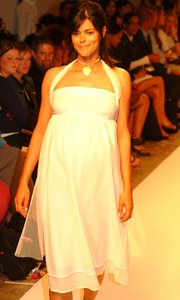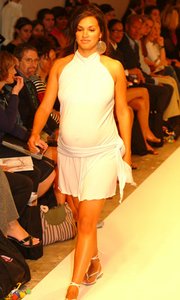The Baby Trend
Retailers expand their offerings for stylish moms-to-be
Babies aren’t exactly the new must-have accessories, but by the looks of recent fashion industry events, pregnancy is quite popular.
Gorgeous women proudly sporting pregnant bellies were on the runway and in the front row during Los Angeles Fashion Week at the Naissance runway show. Richard Tyler closed his fashion show later in the week with a pregnant bride.
And Babystyle—the Los Angeles–based purveyor of fashionable clothing, accessories and gifts for moms, moms-to-be and kids—just opened its second free-standing store, in Santa Monica, Calif., with a three-day party.
According to Kathryn McRitchie, fashion editor of Fit Pregnancy in Woodland Hills, Calif., demand for maternitywear is at an all-time high.
“More people are getting pregnant because these days it’s hip to be pregnant,” McRitchie said. “There are so many new maternitywear designers coming out with stylish and formfitting clothes, and every season it’s getting better.”
Annually, maternity apparel is a $1.2 billion business, according to the National Retail Federation.
The late ’90s ushered in a baby boomlet as the national birth rate increased 5 percent, from 3.8 million in 1997 to 4 million in 2002, according to the National Center for Health Statistics. Though women between the ages of 25 and 29 had the highest birthrate, at 114 births per 1,000 women, birthrates for women between the ages of 35 and 39—when many of them have more disposable income to spend on high-end maternity clothing—were the highest in more than three decades, with 41 births per 1,000 women.
The baby boomlet coincided with the rising popularity of contemporary apparel brands, which ushered in a whole new subcategory of the maternity market: contemporary maternity.
If it’s hip to be pregnant, then it is especially hip to be stylishly pregnant.
“Retailers are looking for a niche, and some are more inclined to participate in emerging trends more quickly than others,” said Ellen Tolley, a spokesperson for the NRF. “Specialty retailers and discount stores have had great success with maternitywear because they’re providing floor space for that segment of the market.”
Indeed, only a few department stores have the space to house a maternity section. Cincinnati-based Federated Department Stores Inc. operates maternity departments in 21 stores in the Midwest through a partnership with Mothers Work Inc., a Philadelphia-based retail chain that operates 900 stores under the Motherhood Maternity, Mimi Maternity and A Pea in the Pod nameplates. Minneapolis-based Target Corp. has a partnership with maternity designer Liz Lange.
For several years, the J.C. Penney Co. Inc. has provided Duo, a line of affordable maternity apparel. The Plano, Texas–based retailer said it is getting ready to introduce some Fall looks that will target young customers looking for contemporary influences.
“We want to provide women with young contemporary fashion, so we have to be right on trend to capture her attention,” said JCPenney buyer Gary Chavez, who works on Duo’s fashion direction with a handful of U.S. vendors. “Silhouettes are getting closer to the body. The modern mother is proud of her body and doesn’t mind showing it off. We’ve challenged our traditional maternity suppliers to show more contemporary lines, and they have stepped up. We have also invited some new vendors to help us bring new energy and excitement to our mix.”
Boutique business
But it is in the boutiques, specialty retailers and e-commerce sites that the maternity business has flourished. These outlets can dedicate the floor space (or Web space) and give the special attention needed to cater to the maternity market.
Jennifer Noonan was looking for that special attention when she was expecting her second child. When she didn’t find it, she opened her own contemporary maternity store, Naissance, in Calabasas, Calif., in 1998. In 2001, she closed the Calabasas location and opened NOM (Naissance on Melrose) on the West end of Melrose Avenue in Los Angeles.
“You have this big pregnant belly, and you were spending $115 on a tank top—you need to have the shopping experience to go along with that, and they didn’t provide that at maternity stores at the time,” Noonan explained.
Noonan began by ordering merchandise from traditional maternity lines and adding in pieces from other manufacturers that would also accommodate the pregnant form.
But when she found herself hard-pressed to find a maternity T-shirt, she began designing her own pieces, beginning with the contemporary looks her customers were asking for: novelty T-shirts, feminine empire mini-dresses and denim styles.
Two years ago, she began full-time production of the NOM label and today carries only her label alongside accessories— such as jewelry and diaper bags—from other manufacturers.
In November, Noonan put her concept on the runway, staging a full-scale fashion show during Mercedes-Benz Shows L.A. at Los Angeles Fashion Week.
Hitting each market
Across the board, there are retailers catering to each segment of the maternity market. Some, such as Naissance, cater to the customer looking for contemporary and designer labels for a maternity figure.
Barneys New York carries maternity apparel from highend labels including Procreation, Chaiken, Cadeau, Cullen Cashmere, Daryl K, Diane von Furstenberg, Juicy Couture, Rebecca Taylor and M.R.S. Better department stores that do sell maternity apparel face the challenge of divvying up floor space among their many segments.
“Maternity has a broad range of components that can go into a department. You can’t do it in a small way,” said Michael Macko, a spokesman for Saks Fifth Avenue. Macko said the high-end retailer recently added special sizes to its merchandise mix, including styles for moms-to-be.
Still, it’s not just the upper end of the maternity market that is performing well. Other retailers and manufacturers are catering to moderate customers.
Uber-retailer Gap Inc. is the latest chain retailer to enter the maternity business. Last year, the San Francisco–based company launched Gap Maternity in 12 of its Baby Gap store locations across the United States. The company is planning a nationwide rollout of the concept.
Gap decided to go into maternity because expecting moms are looking for comfortable clothes that allow them to maintain their individual sense of style throughout their pregnancy, said Gap Director of Public Relations Julie Alonso.
“Our consumers expressed interest in the need for more modern, form-fitting and stylish maternitywear, so we listened, and the result has clearly been positive,” Alonso said. “Since moms-to-be are only able to wear clothing items for a few months, value and versatility are essential.”
E-Mommies
According to some retailers, the next frontier for maternity apparel is cyberspace.
Philadelphia-based retailer Mothers Work has links to ecommerce sites for all three of its divisions on its Web site, www.maternitymall.com. And Naissance has an online presence at www.naissancematernity.com.
Three years ago, Laurie McCartney spent several weeks of her pregnancy putting together a business plan for EStyle Inc., the parent company of Babystyle, and launched her online store three weeks after the birth of her son.
McCartney conceptualized a company that would offer products from several areas of the maternity market—including maternity, baby, gifts and nursery—online at www.babystyle.com or by catalog.
The company has since opened three bricks-and-mortar California locations in Manhattan Beach, Newport Beach and Santa Monica.
“Women shop in lots of different ways, Internet, catalog and bricks-and-mortar stores,” McCartney said. “Beyond our own channels—whether it’s licensing or wholesale—if we think there is something that makes sense for the consumer and Babystyle brand, then we will pursue those opportunities.”
McCartney said the proof is in the company’s sales, which have increased annually by 90 percent since 2001.
Husband-and-wife retail team Roxanne Beckford and Bob Hoge took a similar approach when launching maternity apparel e-commerce site www.onehotmama.com four years ago and then making the jump to a physical location in 2001 on Cahuenga Boulevard in Los Angeles.
One Hot Mama’s light, airy 400-square-foot boutique is more like a showroom than a retail store. It is sparse but has all the comforts of home—there is even an ExerSaucer in the dressing room for toddlers.
The store carries styles by Olian, Japanese Weekend, Mums and Blossums, Juliet Dream and Prego. Styles range from a tiny mama-to-be tankini swimsuit and leopardprint lingerie to georgette dresses; sizes range from 2 to 3X. Beckford also designs a nursingwear collection, sold at the store and on the company’s Web site. “There’s definitely a shortage in terms of fashionable, good-looking nursing clothes,” Beckford said.























